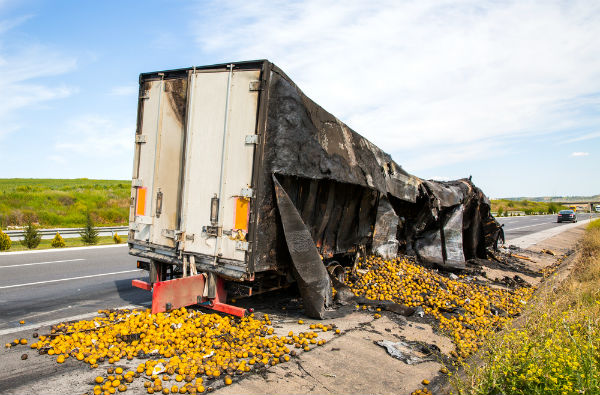Drive Safely Around Big Trucks as if Your Life Depended Upon It

Unfortunately, big trucks and passenger vehicles have to share the road, creating risks for the occupants of the smaller vehicles. During the summer, when many Oklahoma families go on vacations, the danger is greater because of the increase in travel.
Big-truck crashes claimed the lives of 112 people in Oklahoma in 2013, according to the National Highway Traffic Safety Administration (NHTSA). When large trucks collide with passenger vehicles, because of the sheer size and weight of 18-wheelers, people in the smaller cars and pickup trucks almost invariably sustain the more serious injuries.
It’s important to know how to share the roads safely with big trucks. Consider these driving trips when you encounter 18-wheelers:
Blind Spots
- Commercial truck drivers often can’t see you because of limited visibility if you pull into one of the blind areas around their trailer, according to AAA.com. Avoid driving alongside an 18-wheeler or tailgating, because those are the areas truck drivers are least likely to see your vehicle.
- When a truck is backing up, don’t try to pass it from behind. The driver is unlikely to see you or hear your honking horn.
Intersection Turns
- When coming up to intersections, avoid attempting to pass a truck on the right. Big trucks often swing wide so their trailer can clear a curb and other objects in their path. Don’t be fooled into thinking they’re turning left.
- If you’re pulling up to an intersection as an oncoming truck tries to make a right turn, you might have to stop sooner than normal to give them room to negotiate the turn.
Clearance is Crucial
- When driving behind a tractor-trailer, give yourself plenty of space. Big trucks create wind currents that can affect vehicles traveling beside and behind them, seriously threatening your car’s stability if you get too close.
- The threat is even greater for motorcyclists and those hauling trailers or other heavy loads, especially when the roadway is slick.
Beware of Tailgaters
Because of their size and the weight of their loads, big trucks need a greater distance for stopping than passenger vehicles. Rear end collisions involving large trucks are common because of the stopping distance they require.
With that in mind, beware of trucks following your vehicle too closely. If they’re tailgating, check your mirrors and then change lanes if it’s clear to allow them to move on.
A Tulsa, Oklahoma teenager died on June 18 after a semi-truck rear-ended the minivan she was riding in on Interstate 55 near Chicago, Illinois, according to a newson6.com article. The 14-year-old girl was killed and three others in the minivan were injured after the truck hit it in the back, according to police.
Tractor-trailers that tailgate can be dangerous. The standard for big trucks to stop at 60 mph was 355 feet or less until the NHTSA reduced the distance standard to 250 feet in 2012, according to autoblog.com.
NHTSA officials said new braking rules would save 227 lives annually and avert another 300 serious injuries while saving $169 million in property damage from big-truck crashes.
Common Sense Rules
Defensivedriving.com encourages motorists to follow these guidelines:
- Don’t cut off a truck in traffic. Because truck drivers have less visibility and take longer to stop, cutting in front of them in traffic after you pass creates a dangerous situation. If you must pass a big truck, wait until you can see both of its headlights in the rear-view mirror.
- Braking suddenly is never a good idea. But when a big truck is behind you, the results can be especially disastrous. Avoid slamming on your brakes, because it takes big trucks longer to stop.
- Avoid blind spots. If a truck driver can’t see your vehicle, he could pull into your lane and cause a collision. Consider this general rule: If you can’t see a truck’s mirrors, the driver probably can’t see your vehicle.
- If a big truck is merging onto the interstate from a ramp, give them room. If you’re getting off onto a ramp, beware of big trucks because if they’re going too fast while exiting they could turn over.
Remember, truckers are required to drive safely and obey traffic laws just like other motorists. For more people to survive the relationship between big trucks and passenger cars on the nation’s roadways, respect and caution are the keys to avoiding big-truck crashes. When truckers disregard their responsibility to drive safely, they should be held accountable. Learn to share the road and more people will make it to their destinations safely.
Blog CATEGORIES
Let's Talk About It
Speak with an experienced attorney at no cost to you

